
94% of researchers rate our articles as excellent or good
Learn more about the work of our research integrity team to safeguard the quality of each article we publish.
Find out more
ORIGINAL RESEARCH article
Front. For. Glob. Change, 13 March 2025
Sec. Forest Management
Volume 8 - 2025 | https://doi.org/10.3389/ffgc.2025.1539025
This article is part of the Research TopicStructure and Functioning of Alpine Treeline EcosystemsView all 5 articles
 Muhammad Shakeel Khan1
Muhammad Shakeel Khan1 Shujaul Mulk Khan1*
Shujaul Mulk Khan1* Abdullah2,3
Abdullah2,3 Jie Liu2,3*
Jie Liu2,3* Zeng-Yuan Wu2,3
Zeng-Yuan Wu2,3 Jawad Hussain1
Jawad Hussain1 Shakil Ahmad Zeb1
Shakil Ahmad Zeb1 Nazir Mohammad1
Nazir Mohammad1 Zareena Batool1
Zareena Batool1 Zafeer Saqib4
Zafeer Saqib4 Rabia Afza5
Rabia Afza5 Fazal Manan1
Fazal Manan1 Shahab Ali1*
Shahab Ali1*Introduction: The Hindu-Himalayan region, a global biodiversity, hotspot harbors numerus endemic plant species that contribute significantly to ecosystem stability. Among these, Iris hookeriana, an endemic perennial herb, thrives in the subalpine and alpine zones of the Hindu-Himalayas. The study aimed to assess the population dynamics of Iris hookeriana, assesses the primary threats to its survival, and explores its ecological associations along with with indicator species.
Methods: Fieldwork was conducted across 35 distinct sites, at the elevation range of 2,500 m–3,900 m above sea level. A random stratified sampling method using quadrats, was employed to assess both qualitative and quantitative plant characteristics. Edaphic, topographic, geographic coordinates, and elevation Global Positioning System (GPS) data were recorded on each sampling site. Plant species associations were analyzed using 5 m2 × 5 m2 quadrat for shrubs and 1 m2 × 1 m2 quadrat for herbaceous vegetation. The relationships between species composition and environmental variables were analyzed via Statistical analyses, including Detrended Correspondence Analysis (DCA), Canonical Correspondence Analysis (CCA), Two-Way Cluster Analysis (TWCA), and Indicator Species Analysis (ISA), were conducted using PCORD version 5.0.
Results: Seventy associated plant species from 26 families were identified across 35 sampling sites, revealing four major plant associations: (1) Arenaria-Viola association, (2) Nepeta-Oxytropis association, (3) Phlomis-Prunella association, and (4) Bistorta-Carex association. These associations exhibited significant correlations (p < 0.05). The identification of these four novel plant associations provides a crucial baseline for understanding the ecological dynamics of the subalpine and alpine ecosystems. The study emphasizes the significant role of environmental factors i.e., altitude, organic matter, pH, humidity, total dissolved solid, electrical conductivity, nitrogen, phosphorus, silt, and clay content in shaping the Iris hookeriana population within the subalpine and alpine zone of Hindu-Himalayan Mountains.
Discussion: The findings show that indicator species and plant associations vary with changing environmental conditions, providing valuable insights for sustainable biodiversity management in subalpine and alpine ecosystems of the Hindu-Himalayan mountains.
The Himalayas are recognized as a major biodiversity hotspot region, presenting diversified fauna and flora with several endemic species. The rich biodiversity of the Himalayas is because of its unique geography and diversified microclimatic weather (Tali et al., 2019; Dar and Khuroo, 2020). Currently, the biodiversity of the Himalayas is under intense pressure because of anthropogenic activities, drastic changes in land use systems, and climatic changes (Hamid et al., 2020; Hassan et al., 2021). Loss of flora in the Himalayas is because of unsustainable medicinal uses which make species vulnerable and ultimately species lead to extinction (Ganie et al., 2019; Tali et al., 2019; Abdullah and Khan, 2023). Such variation in the environment influences the plants to bring changes and adjust to the environment, especially plants found in specific habitats of the Himalayan region (Davis, 1992). Comparable to plant adaptation environmental changes are rapid in the environment (Davis and Shaw, 2001). In the field of vegetation science, assessment of medicinal plants is important, and other scientific disciplines as well as management, bioprospecting, and conservation of Phyto resources (Teixidor-Toneu et al., 2025; Magray et al., 2022; Rashid S. et al., 2023). Natural communities are crucial to studying the composition of the species, structure, abundance, population, and interaction of species in the environment (Chawla et al., 2012; Mishra et al., 2012). Alpine zones occur where trees are unable to grow however, several plant species thrive due to their adaptations to the harsh climatic conditions of the alpine zone (Nagy and Grabherr, 2009). Approximately 3% of the Earth’s vegetated land area is covered by the alpine zone (Körner, 2011). Which hosts about 4% of the world’s plant species, with an estimated 8,000–10,000 species (Nagy et al., 2012). Most of the species are perennial and have adapted to the extremely harsh habitat (Grabherr et al., 2010). The life forms of alpine plants include succulents, graminoids, forbs, and mat-forming cushions (Jabis, 2018). The composition and diversity of species within the alpine zone depend on various factors, including different mountain ranges, as well as altitudinal and latitudinal gradients (Malanson et al., 2020). Geographically, an alpine ecosystem is classified based on water availability, seasonality, and elevation; all these factors play a crucial role in shaping the biotic composition of plant associations (Grabherr et al., 2010; Körner, 2011).
In the Himalayan region, the genus Iris contributes significantly to plant diversity, thriving abundantly in open grasslands, sub-alpine and alpine environments, graveyards, gardens, saffron fields, and along stream banks. Some species within the Iris genus are cultivated, while others grow wild such as Iris hookeriana (Zeerak and Wani, 2007). Among the species of Iris, a notable and endemic variety in the Himalayas is Iris hookeriana, a member of the family Iridaceae, small herb that features a long stem, a short perianth tube, a slender rhizome, and blue-purple flowers adorned with darker blotches, typically found on open grassy slopes at high altitudes above sea level, locally referred as Mazarmund in India, and Toori in Swat and Shangla district of Pakistan (Polunin and Stainton, 1984). Climate change significantly impacts various species, particularly as temperatures decrease at high altitudes in the Himalayas and precipitation patterns shift, both of which have detrimental effects (Negi et al., 2012; Devi et al., 2024; Sekar et al., 2024). Overharvesting is another critical issue, as local communities often utilize Iris hookeriana for ornamental purposes due to its attractive purple flowers. Phytochemicals such as isoflavones (iridin, junipigenin-A, irisflorentin, irigenin) and stilbene glycoside (piceid) have commonly isolated chemicals form rhizomes of Iris hookeriana (Tariq et al., 2008). Additionally, the rhizome is harvested for medicinal uses, further contributing to the decline of the species (Hopping et al., 2018). Other factors exacerbating the situation include habitat degradation, infrastructure development, habitat loss, and fragmentation.
Iris hookeriana is a significant species in the Hindu-Himalayan Mountain ranges, playing a crucial role in the ecosystem. Studies on Iris hookeriana are remarkably scarce, particularly regarding the specific plant associations involved. The distribution of Iris hookeriana and how these plant species are influenced by environmental factors. Factors remain largely unexplored. This study addresses this critical gap by providing the first comprehensive characterization of plant associations linked to Iris hookeriana. Hindu-Himalayan Mountain ranges have been studied, leading to the identification of four distinct and previously unreported plant species associations.
The study was designed with specific objectives to evaluate the population dynamics of Iris hookeriana across the subalpine and alpine Hindu-Himalaya Mountains range to enlighten conservation management strategies for this species. This study also investigates the associated plant species of Iris hookeriana, with a particular focus on identifying indicator species that could provide insights into their ecological preferences and habitat conditions within the studied subalpine and alpine region of Hindu-Himalaya Mountains eventually contributing to ecosystem conservation and sustainability (Figure 1).
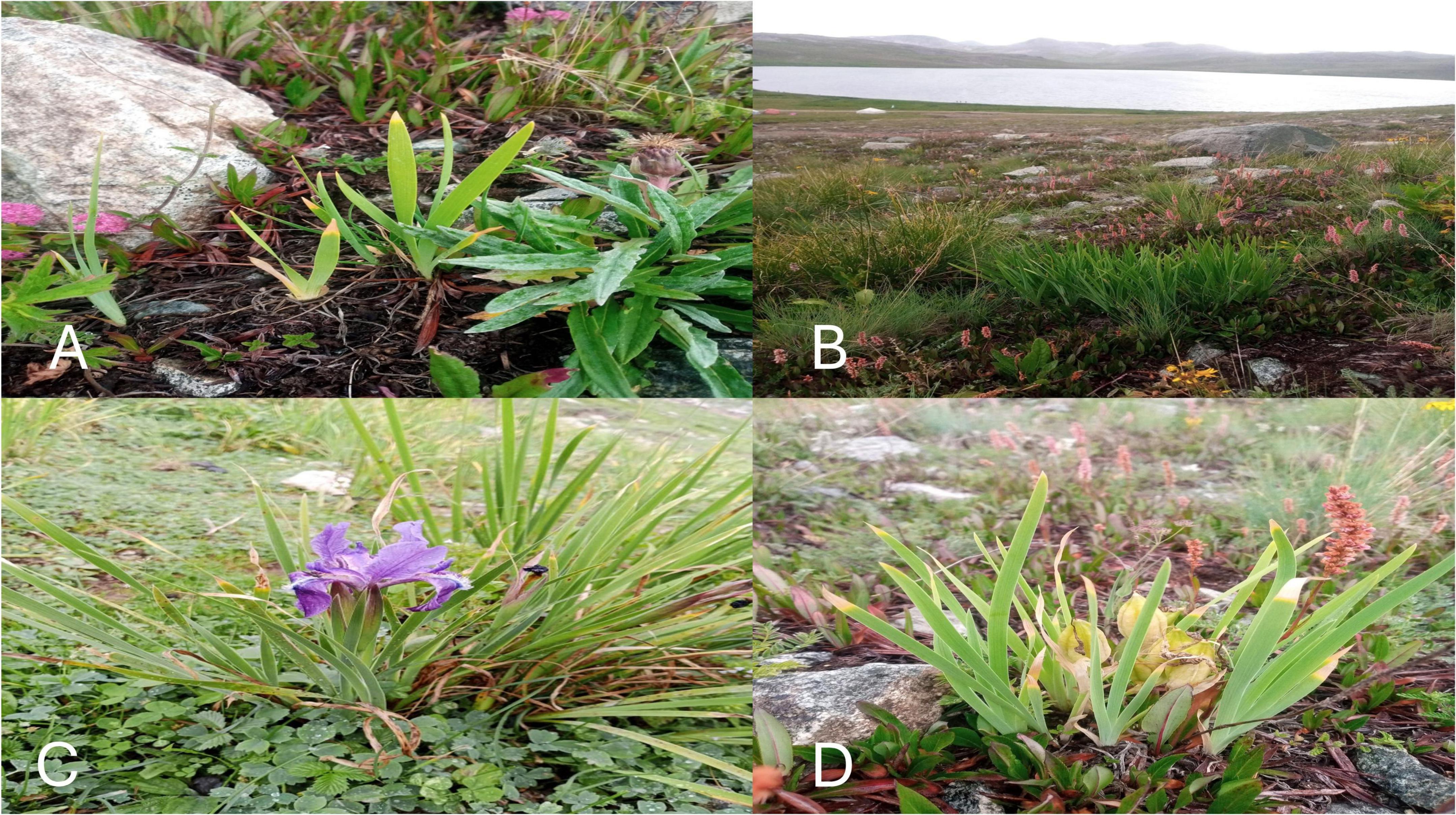
Figure 1. Life stages of Iris hookeriana: (A) Juvenile, (B) Mature, (C) Flowering, (D) In the fruiting stage.
This study was conducted in the Hindu-Himalaya Mountains, which are characterized by high-altitude meadows, extensive green cultivated fields, towering mountain peaks, snow-capped glaciers, and scenic tributary rivers, streams, lakes, and ponds. The region hosts a diverse range of flora throughout the seasons, driven by its varied topography, geological features, habitats, and climatic conditions (Ali et al., 2024). The climate is characterized by distinct seasons, with moist summers and cold, snowy winters. The area boasts a diverse range of vegetation, including a significant population of medicinal and aromatic plants (Thapa et al., 2021; Sekar et al., 2024). Additionally, there are several endemic plant species, as well as a rich variety of wildlife. Due to the unique climatic and topography conditions, plant diversity is notably high. Indigenous communities engage in livestock breeding and agriculture (Rao et al., 2003; Farooquee et al., 2004; Figure 2).
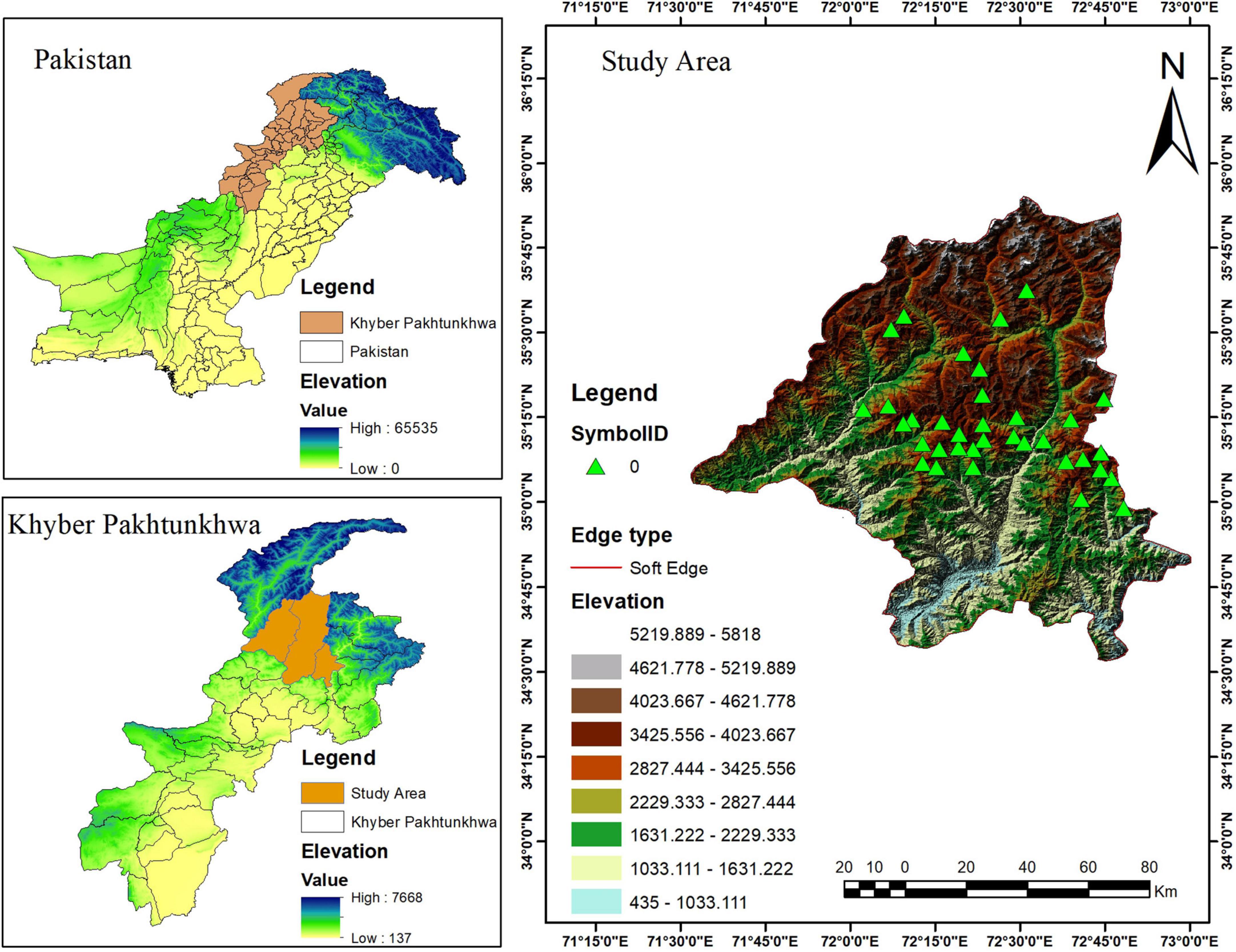
Figure 2. Map of the study area in the Hindu-Himalayan region, showing (top left) location within Pakistan, (bottom) the province, and on the right, a detailed map of the specific area where the field work was conducted.
Thirty-five sampling sites were selected to represent the study area. Within each sampling site, quadrats were established to assess plant associations and composition. The size of the quadrat depend on the Iris hookeriana where it was found if the Iris hookeriana was growing with herbaceous plants (herbs), we used (1 m × 1 m2) quadrat. Where Iris hookeriana was growing with shrubs, we used quadrats of (5 m × 5 m2) (Khan et al., 2013c; Khan M. et al., 2017; Mumshad et al., 2021) growing. Soil samples were collected from all the 35 sampling sites for edaphic analysis. We calculated density, relative density, cover, relative cover, frequency, and relative frequency. The Importance Value Index (IVI) was derived from all quadrats based on their relative indices with the help of the following formulas (Mumshad et al., 2021; Rashid S. et al., 2023). Plant samples were labeled, pressed, and dried before being mounted on herbarium sheets and stored at the Plant Ecology and Conservation Laboratory at Quaid-i-Azam University Islamabad for future research. A Global Positioning System (GPS) (model Garmin eTrex. HC series, vista HCx) were used to measure geographic coordinates, including altitude, latitude, and longitude.
Moisture content of the soil samples was found out on oven dry soil weight (Model: DSO-300D) as per the method of Rashid K. et al. (2023) with the help of the following formula
All the collected soil samples from 35 different sampling sites were replicated three times to ensure reliability and reproducibility Before analysis, the samples were cleaned of stones, plant roots, and other extraneous materials, then stored in polythene bags and properly labeled with their respective codes (Bergeron et al., 2013; Ahmad et al., 2019). The soil samples were analyzed in the Plant Ecology and Conservation Laboratory. The following parameters were determined: For measuring electrical conductivity, the samples were saturated with water, filtered, and readings were recorded using an electrical conductivity meter was measured by (model: AD 1030), Total Dissolved Solids (TDS) was measured by (Model: AD 3000), pH was measured by (model: AD 1030 pH/mV), Moisture Content (MC), Humidity, Organic Matter (OM), Nitrogen (N), Phosphorus (P), Potassium (K) and Sieve meshes were employed to assess the soil texture (Sand, Silt, and Clay) of each sample (Iqbal et al., 2018; Anum et al., 2019; Noreen et al., 2019; Rhoades, 1996; Corwin and Lesch, 2005). Soil organic matter was quantified using a standardized solution of iron (II) sulfate (FeSO4) and potassium dichromate (K2Cr2O7) (Nelson and Sommers, 1982; Gallardo et al., 1987). The ammonium bicarbonate-diethylenetriaminepentaacetic acid (AB-DTPA) soil test was conducted to analyze Phosphorus, Nitrogen, and Potassium, following the method described by Soltanpour (1991). In addition to soil analysis, we also documented other features in each of the 35 sampling sites, including aspect, soil erosion, grazing pressure, habitat destruction, uprooting, and other anthropogenic pressures in the field (Khan et al., 2016; Khan W. et al., 2017).
All the collected data of plant species, environmental variables, and edaphic factors data were organized, to find out the relationship between them (Mayor et al., 2017). Importance value index (IVI) data of all the recorded plant species (70 species) and the data from 35 different sampling sites were compiled via the MS EXCEL spread sheet and arranged according to the software requirement. CANOCO version 5.0 software was used to perform Detrended correspondence analysis (DCA) and canonical correspondence analysis (CCA) Cluster analysis, two-way cluster analysis and indicator species analysis were performed through PC-ORD version 5.0 to find out major plant associations (Haq et al., 2017). These analyss were based on the pattern of similarity through Sorenson Distance Measurement using Ward’s linkage Method (Haq, 2018; Rahman et al., 2023) Presence-absence (1, 0) data were utilized to classify fields and associations through cluster analysis (CA) and two-way cluster analysis (TWCA) which is based on the associated abundance data. The abiotic factor and species abundance data matrices were analyzed together to assess the impact of edaphic factors and another environmental variable on association formation through indicator species analysis (ISA) of various associations. Several abiotic parameters were examined to evaluate their effects on species composition, diversity, and aggregation. Independent abiotic parameters were employed to find indicator species within individual associations, with selected indicator species exhibiting a probability of P < 0.05. Additionally, a generalized linear model (GLM) was applied to explore the relationships between abiotic factors and species abundance across the variables.
A total of seventy different plant species associated with Iris hookeriana were recorded from 35 sampling sites from the Hindu-Himalaya Mountains. Almost 95% of the associated flora consists of herbaceous species, with only a small proportion of shrubs. No climbers or other growth forms were seen among the associated plants.
Detrended Correspondence Analysis (DCA) was applied to assess the distribution patterns of 70 plant species along the detrended gradient analysis. Axis 1 and Axis 2 show the primary ecological gradients changing the composition of the species relating to variations in biotic and abiotic properties of the environment. The DCA ordination plot shows distinct clustering of the species that show similar environmental preferences and requirements of the habitat among closely related taxa. The species that are broadly separated along the ordination axes show distinct ecological requirements (Figure 3).
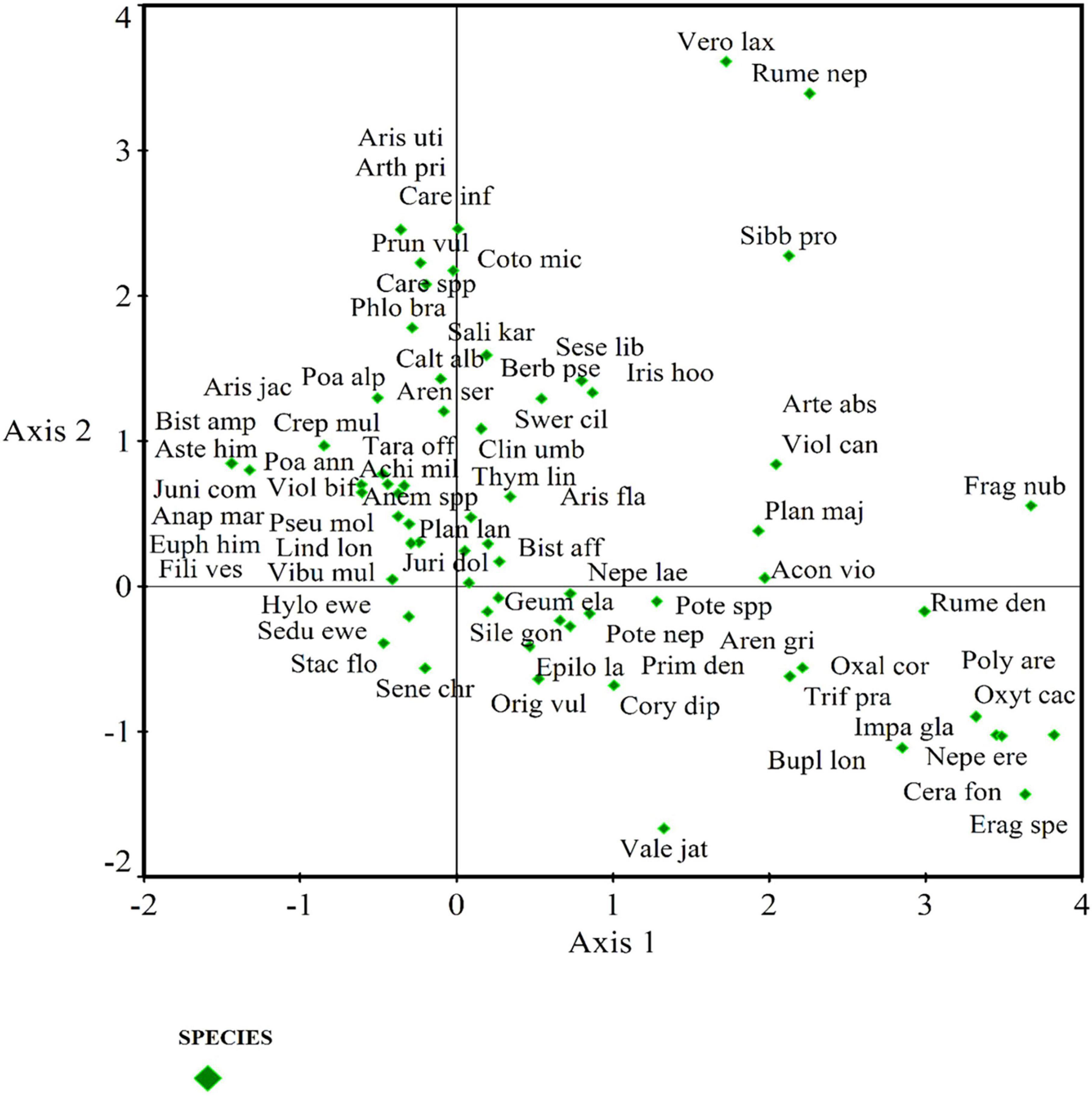
Figure 3. Detrended Correspondence Analysis (DCA) plot illustrates species distribution along the ecological gradient.
The Canonical Correspondence Analysis (CCA) a multivariate statistical technique to analyse the relationships between species and environmental variables including altitude, anthropogenic pressure, aspect, electrical conductivity, grazing pressure, humidity, moisture content, nitrogen, organic matter, pH, phosphorus, potassium, sand, silt, clay, soil erosion, and total dissolved solids. These findings illustrate the dependence of the distribution of species across the environmental variables (Figure 4).
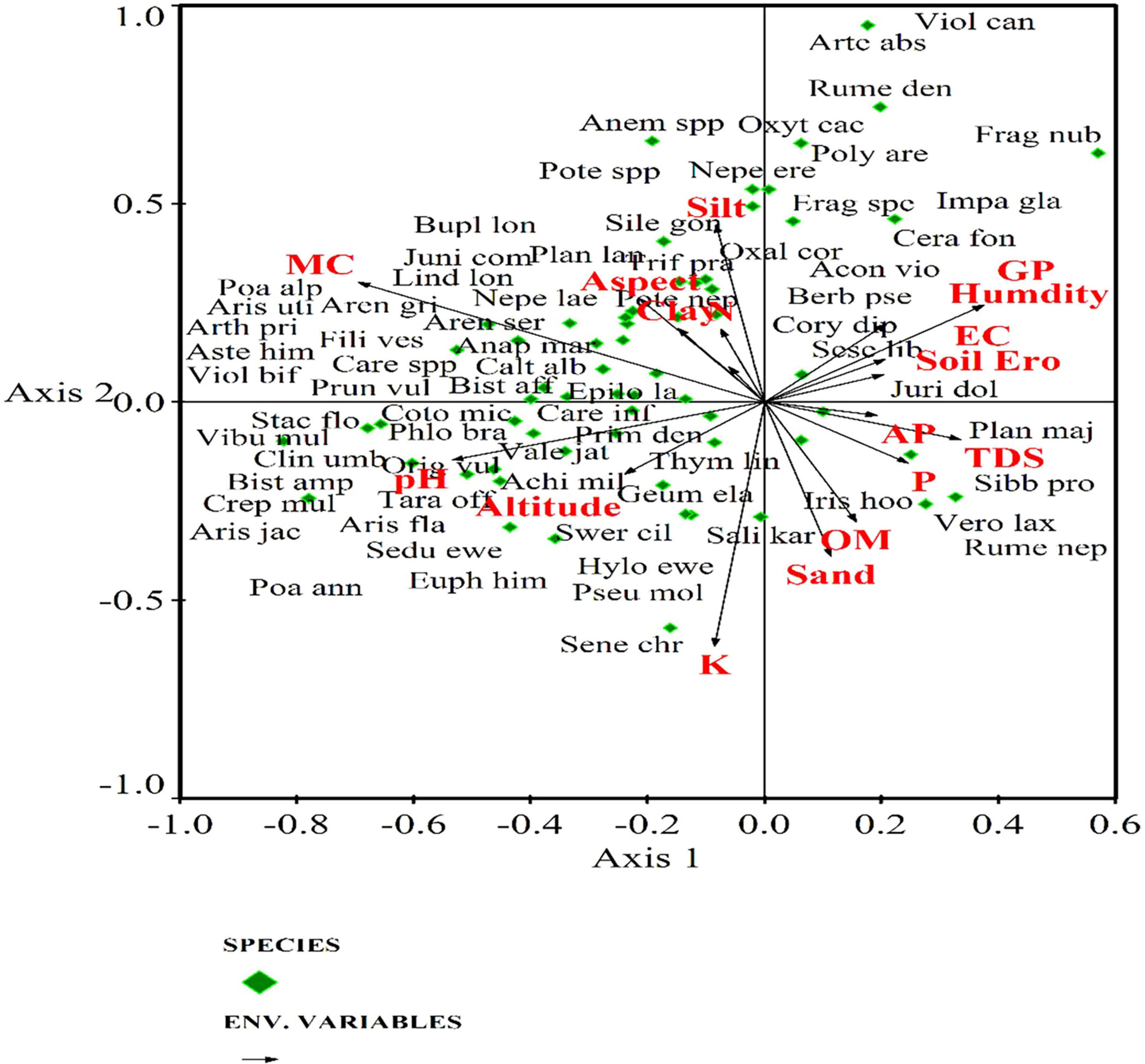
Figure 4. Canonical Correspondence Analysis (CCA) ordination showing the relationships between plant species and environmental variables.
We employed a generalized linear model (GLM) to investigate the impact of various environmental factors on the abundance of Iris hookeriana. The (GLM) graphs illustrate the predicted species’ abundance across different environmental gradients, with the red line standing for the model’s output. This approach allowed us to find key environmental variables that influence the species’ distribution and evaluate its abundance under diverse ecological conditions. The red line provides a clear representation of the interactions between the species and its surrounding environment (Figure 5).
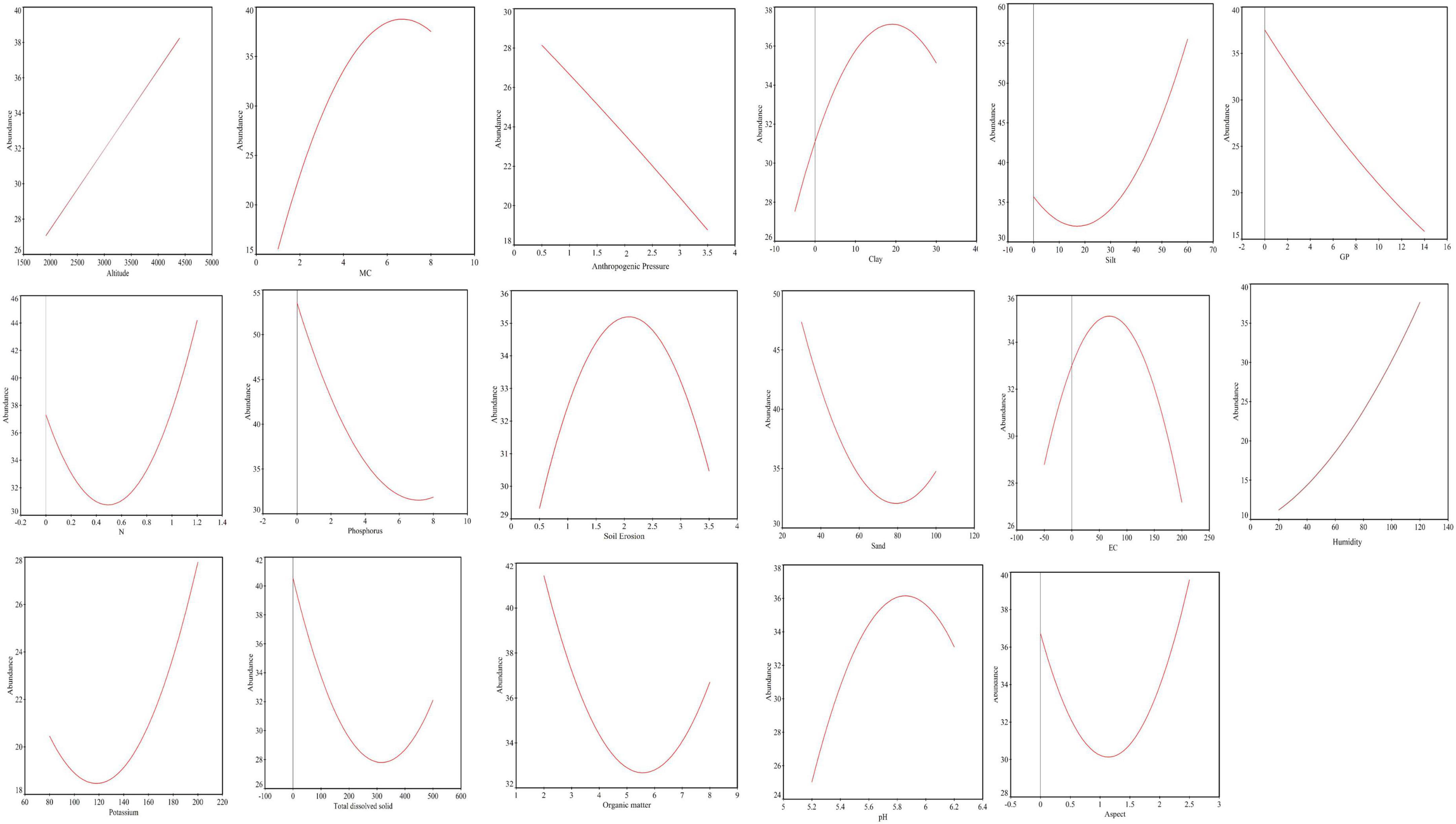
Figure 5. Effects of environmental variables on species abundance [Generalized Linear Model (GLM) results].
Owing to environmental factors, plant species are confined to specific habitats. A cluster analysis of the seventy plant species and the environmental variables divided the thirty-five sampling sites into four main groups, which we refer as plant associations (Figure 6).
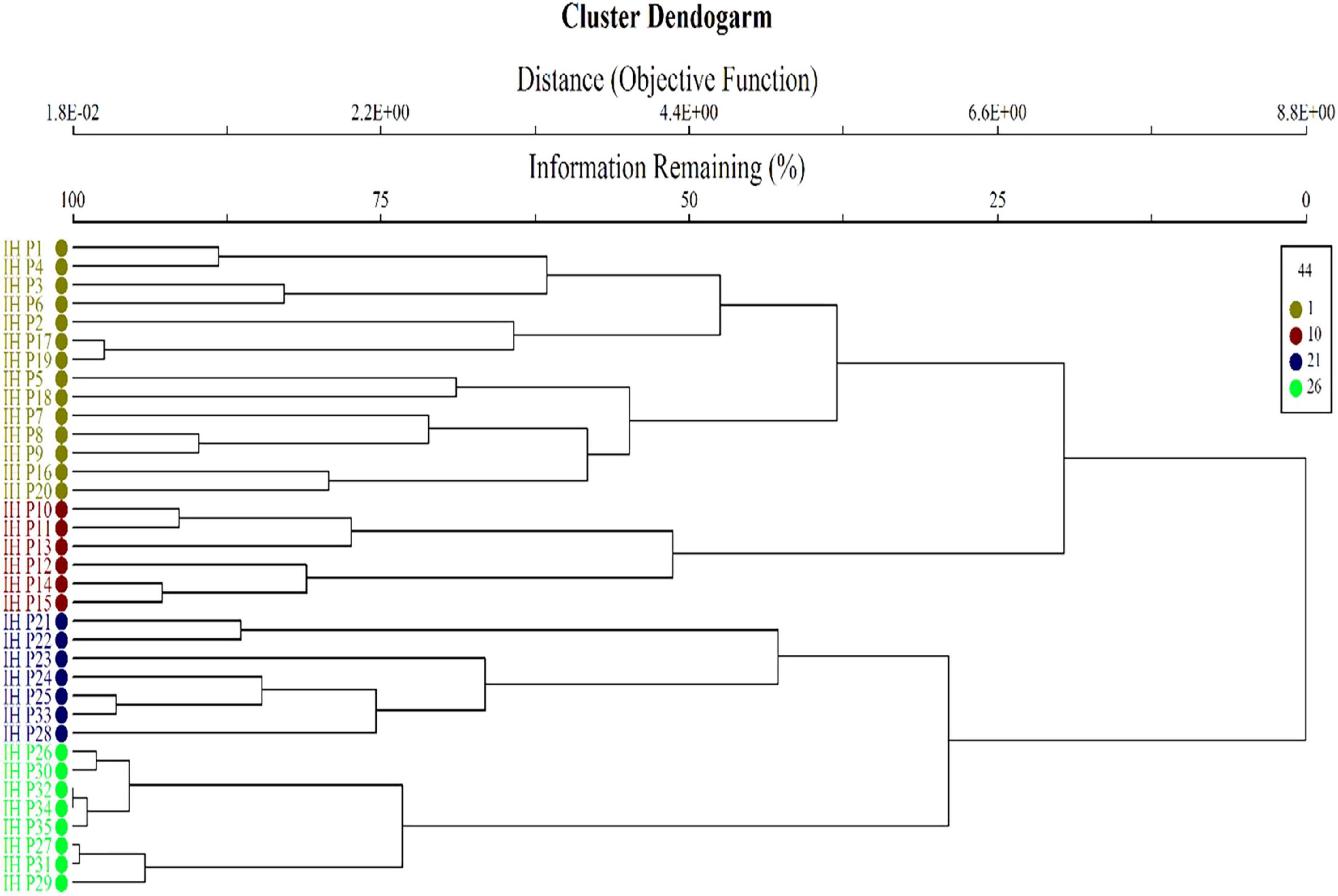
Figure 6. Cluster analysis based on the Sorensen measure, conducted using PC-ORD version 5 software, revealed four different plant associations.
The Two-Way Cluster Analysis (TWCA) provides a comprehensive overview of species distribution across the sampling points. In (TWCA) white dots represent the absence of species, while black dots indicate their presence in a specific area of fieldwork (Figure 7).
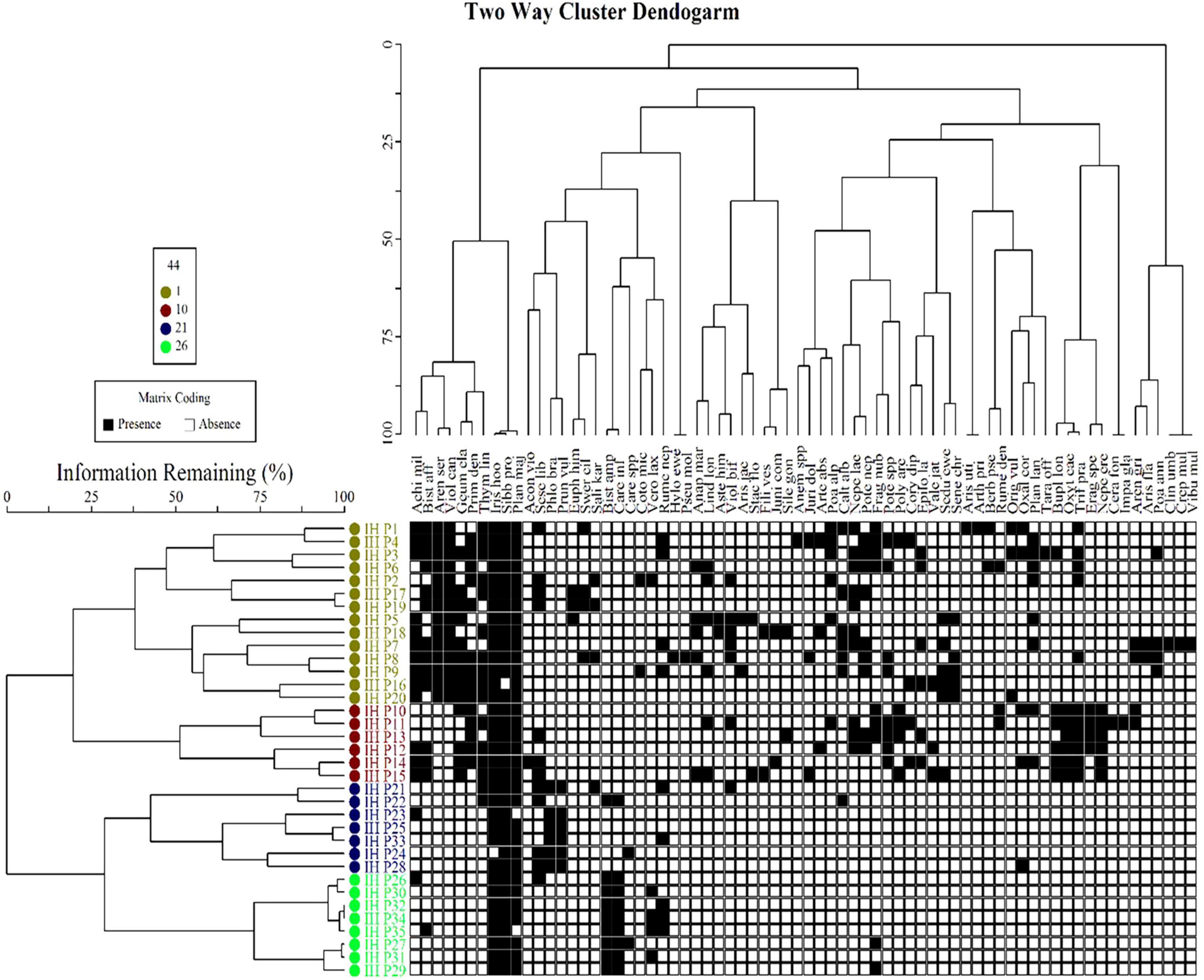
Figure 7. The dendrogram is based on two-way cluster analysis, illustrating the distribution pattern of seventy species across thirty-five different sampling sites.
The indicator species analysis revealed that all top indicator species in the subalpine and alpine zones are herbs, as these areas are herbaceous. Each of the four associations is characterized by two top indicator herb species, all with significant values (P < 0.05) and observed indicator values greater than 20, highlighting the dominance of herbs in these ecosystems (Table 1). An inclusive description of identified associations, their co-indicator plant species, and the corresponding environmental factors is discussed below.

Table 1. The top two indicator species for each association were identified based on the association’s name.
The leading indicator species of this association are Arenaria serpyllifolia (OIV = 27.9) and Viola canescens (OIV = 50), with significant p-values of 0.04 and 0.039, respectively. This association, is found in the subalpine and alpine zones at elevation ranges between 2,500 m and 2,900 m. Other indicator species within this association include Achillea millefolium, Salix karelinii, Artemisia absinthium, Berberis pseudumbellata, and Juniperus communis. Arenaria serpyllifolia and Viola canescens are under the influence of edaphic gradients, such as altitude, organic matter, clay content, humidity, and electrical conductivity, significantly influence the structure of association 01 and the distribution of associated plant species in the study area (Figure 8).
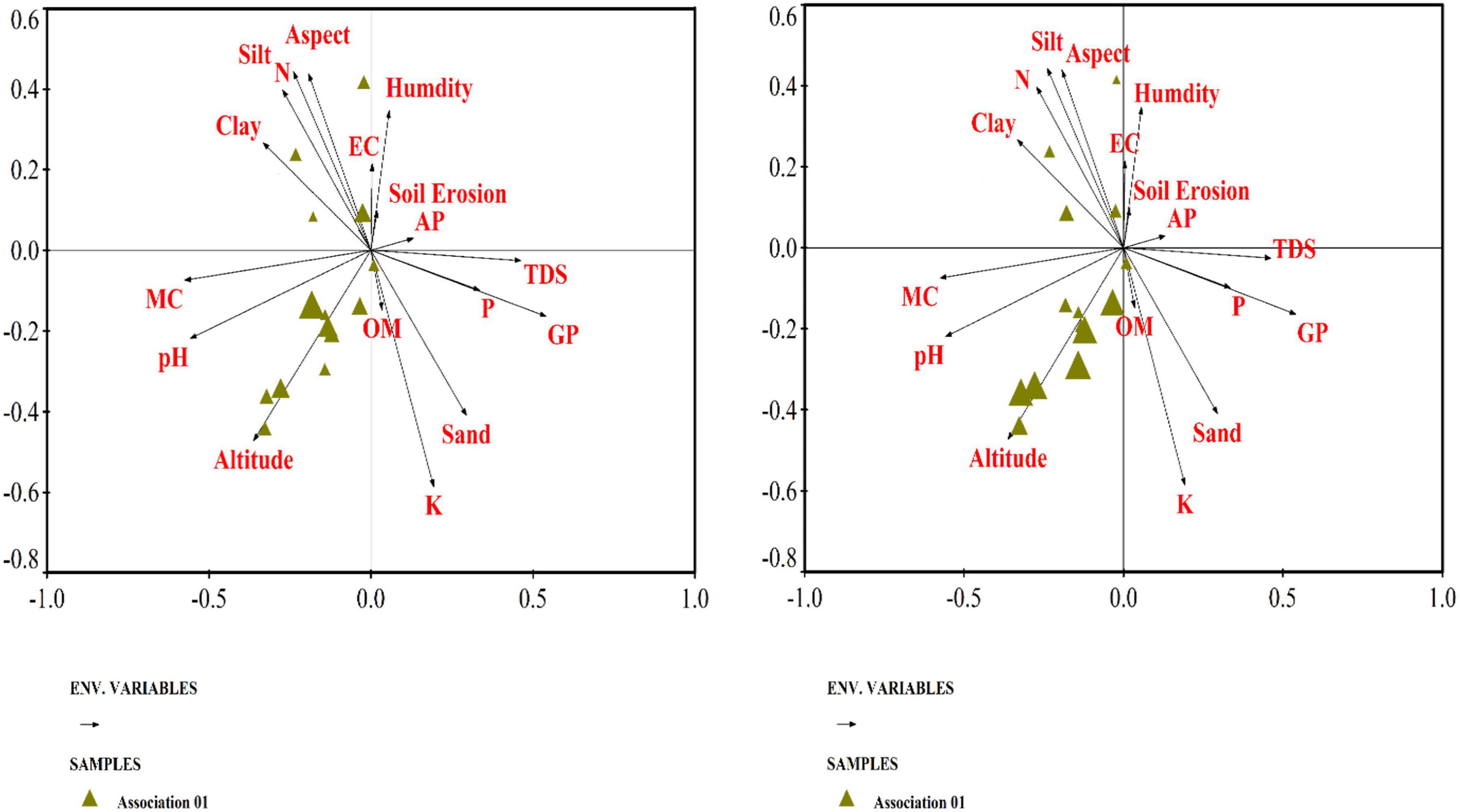
Figure 8. Data attribute plots (from left to right) of indicator species for Association 1 (Arenaria serpyllifolia and Viola canescens).
The leading indicator species of association 02 are Nepeta erecta (OIV = 68.4) and Oxytropis cachemiriana (OIV = 50), with significant p-values of P = 0.042 and P = 0.0591, respectively, both below the 0.05 P-value. This association is found at an elevation range between 2,900 m and 3,200 m. Other indicator species in this association include Corydalis diphylla, Filipendula vestita, Geum elatum, Caltha alba, Jurinea dolomiaea, Lindelofia longiflora, Nepeta laevigata, and Origanum vulgare. Electrical conductivity, clay, silt, and nitrogen concentration play a vital role in the determination of this association 02 (Figure 9).
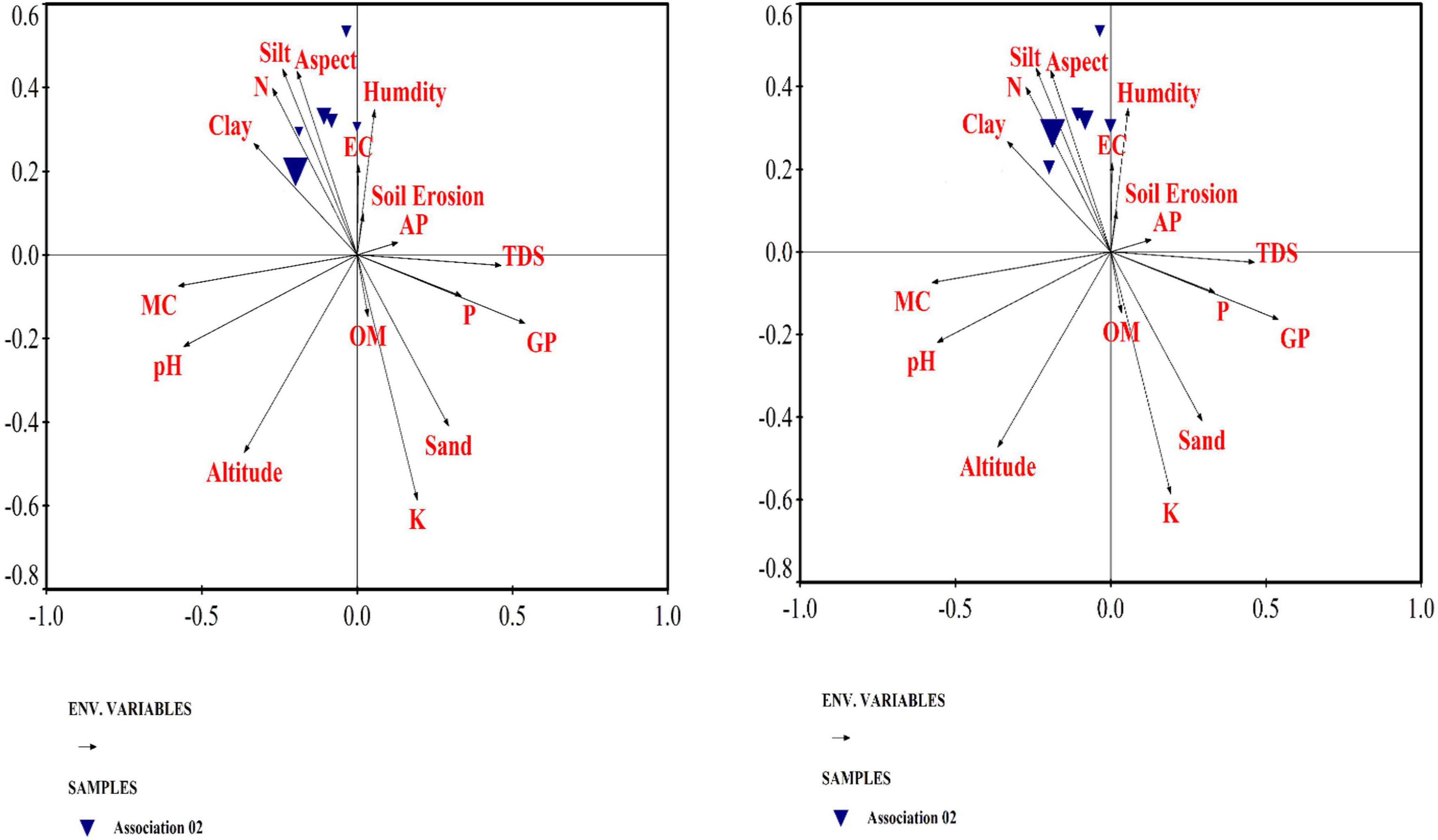
Figure 9. Data attribute plots (from left to right) of indicator species for Association 2 (Nepeta erecta and Oxytropis cachemiriana).
The leading indicator species of association 03 are Phlomis bracteosa (OIV = 44) and Prunella vulgaris (OIV = 39.6), with significant p-values of 0.009 and 0.046, respectively. This association is found an elevation range between 3,200 m and 3,500 m. Other indicator species in this association include Poa alpina, Polygonum arenastrum, Potentilla nepalensis, Pseudomertensia moltkioides, and Anaphalis margaritacea. Prominent levels of total dissolved solids, phosphorus, and organic matter strongly influence the composition and structure of this association 03 (Figure 10).
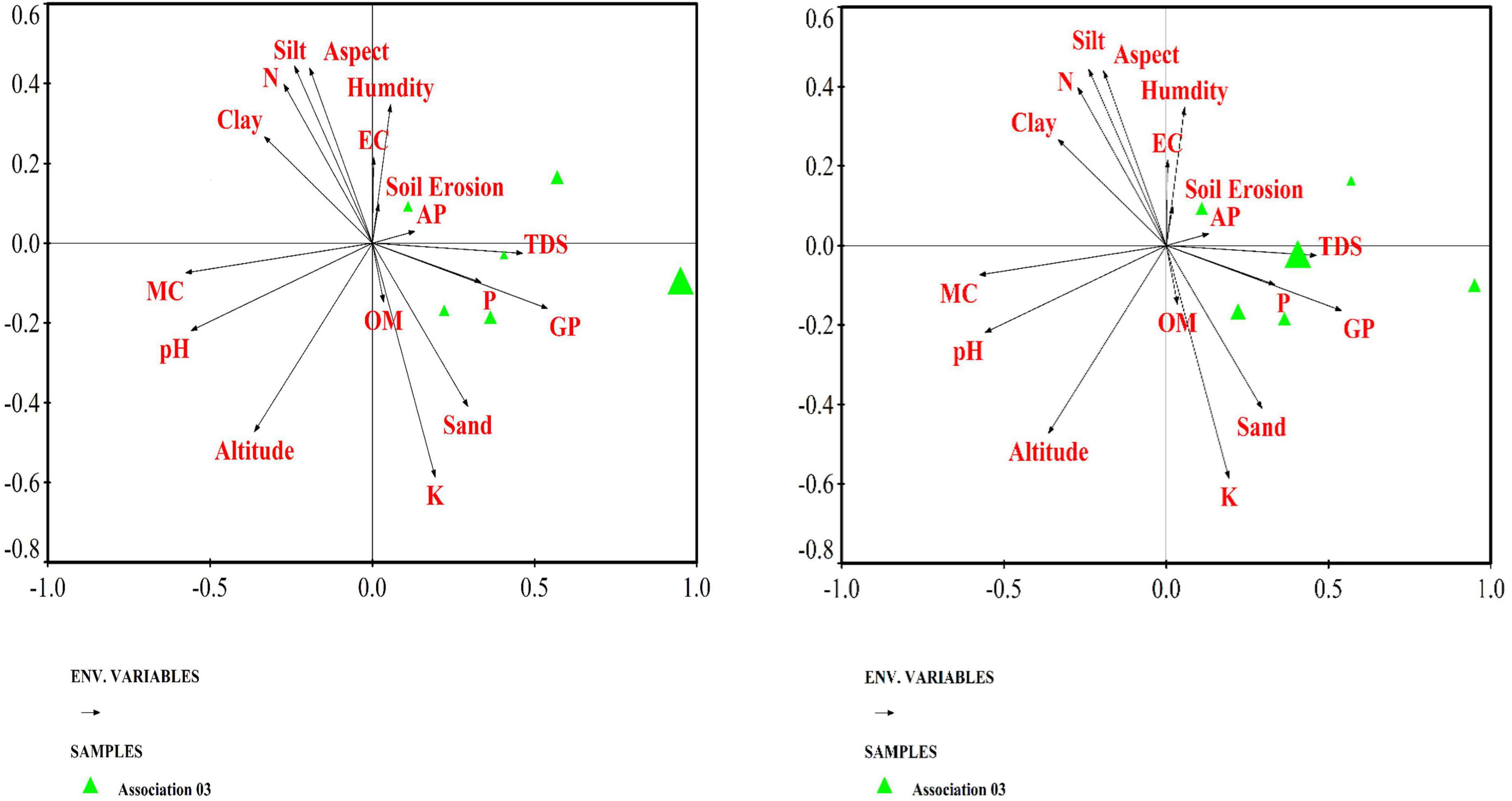
Figure 10. Data attributes plots (from left to right) of indicator species for Association 3 (Phlomis bracteosa and Prunella vulgaris).
The primary indicator species of association 04 are Bistorta affinis (OIV = 52.6) and Carex infuscata (OIV = 66.7), with significant p-values of 0.01 and 0.022, respectively. This association is found an elevation range between 3,500 m and 3,900 m. Other indicator species within this association include Sedum ewersii, Senecio chrysanthemoides, Sibbaldia procumbens, Thymus linearis, and Viola biflora. This association is heavily influenced by high levels of total dissolved solids, phosphorus, and organic matter. However, minimal contributions from other edaphic factors, such as potassium, nitrogen, silt, clay, and electrical conductivity, were observed in this association 04 (Figure 11).
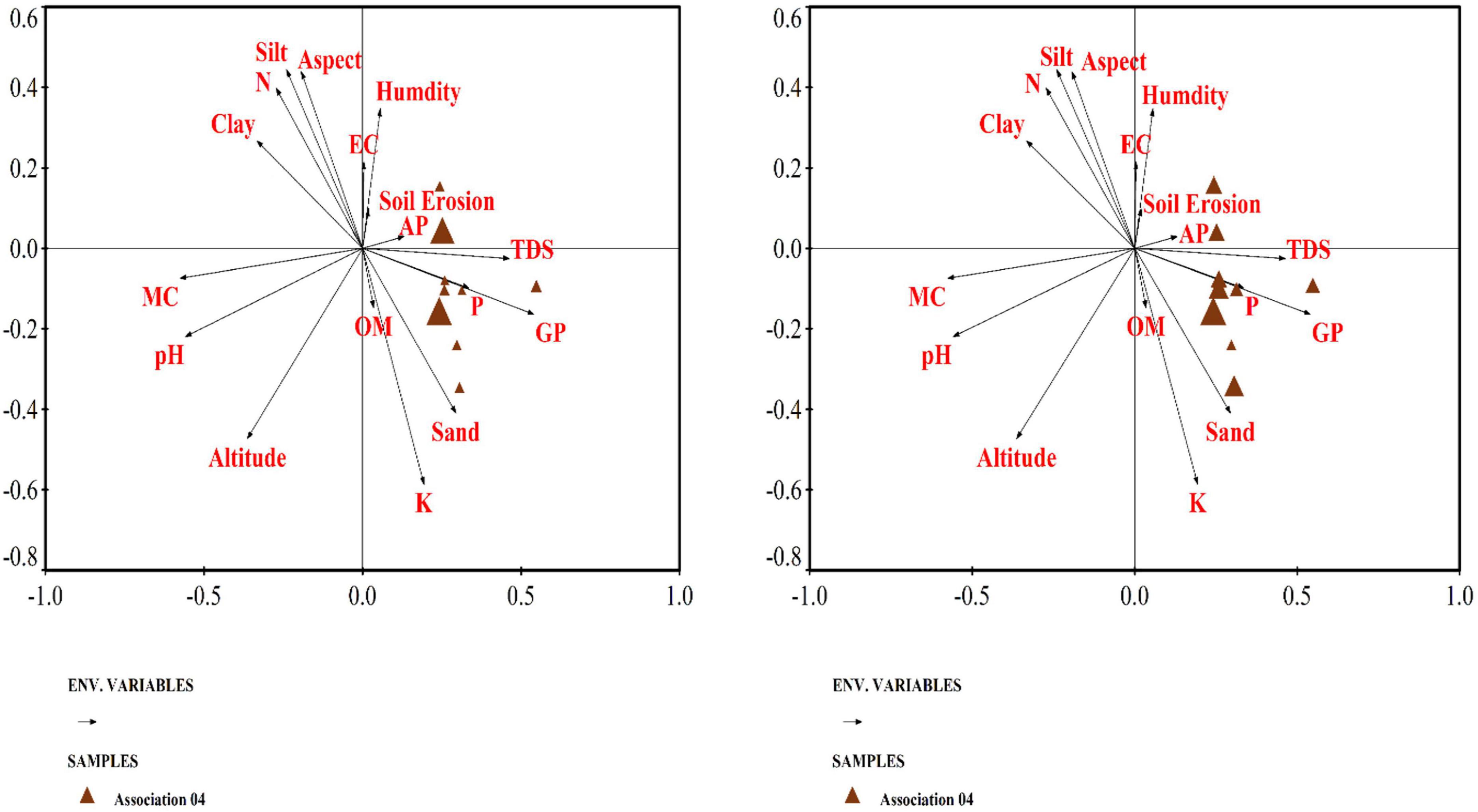
Figure 11. Data attributes plots (from left to right) of indicator species for Association 4 (Bistorta affinis, and Carex infuscate).
Our study documented seventy plant species across 26 different plant families associated with Iris hookeriana. The most dominant families were Asteraceae and Lamiaceae, each contributing eight species, followed by Rosaceae with seven species. The next most prominent families were Apiaceae and Polygonaceae, each with five species. Caryophyllaceae and Poaceae contained four species each, while Plantaginaceae and Ranunculaceae had three species each. Families such as Boraginaceae, Crassulaceae, Cyperaceae, Fabaceae, and Violaceae were represented by two species each. Additionally, Adoxaceae, Balsaminaceae, Caprifoliaceae, Cupressaceae, Gentianaceae, Iridaceae, Onagraceae, Orobanchaceae, Oxalidaceae, Papaveraceae, Primulaceae, and Salicaceae were each represented by one species. Our findings are supported by Rahman et al. (2020). Various environmental variables and anthropogenic activities typically influence high-altitude species distribution, composition, and association. This study examines several factors, including edaphic, topographic, and environmental variables, to understand their roles in shaping subalpine and alpine species composition, association formation, and identifying indicator species. Many such kinds of studies have been undertaken to study wild plants in ecosystems other than tree lines. A notable gap in research focused on such types of high-altitude species in different regions of the alpine zone. Several research articles have also documented alpine species of the Himalayas across various habitats (Ali et al., 2022). Similarly, other studies have focused on individual subalpine species across different habitats, as Manzoor et al. (2024). Investigated the effect of various environmental variables on the distribution of Iris hookeriana using TWINSPAN and DECORANA as classification and ordination techniques (Shehata and Galal, 2014). In the present study, the four major plant associations have resulted. The use of such a robust procedure can be observed quite often for the classification of natural vegetation (Shaheen et al., 2011; Khan et al., 2012; Shaheen et al., 2015; Singh and Yadav, 2024). The top indicator species of each association were recorded based on environmental gradients i.e., edaphic factors, topography, and climatic variables. Such a methodology for association was also followed by Khan et al. (2013a,2014), Shah et al. (2015), Ahmad et al. (2016a), Ahmad et al. (2016b), Khan et al. (2016), Khan M. et al. (2017). The classification of various plant species into different plant associations, along with their indicator species, was conducted in this study.
A study conducted in the subalpine zone of the Himalayas, specifically in Manoor Valley, identified 56 plant species across twenty-one sampling sites. The researchers distinguished four major plant associations, with soil gradients playing a crucial role in shaping and supporting these associations. In current phytosociological research vegetation at higher elevations features key indicator species and characteristic plants typical of sub-alpine and alpine zone Such as Arenaria serpyllifolia, viola canescens, Nepeta erecta, Oxytropis cachemiriana, Phlomis bracteosa, Prunella vulgaris, Bistorta affinis, and Carex infuscate (Tasser et al., 2008; Qiong et al., 2010; Rixen et al., 2022; Shaheen et al., 2023) Various environmental factors define the boundaries of altitudinal zones, including altitude, humidity, temperature, and species interactions. These factors contribute to the formation of distinct associations along with the elevation gradient. Similar plant populations influenced by these environmental parameters have also been reported by Haq et al. (2015), Khan and Ahmad (2015).
Our research shows that the endemic plant Iris hookeriana shows a significant positive correlation with elevation. The species is more abundant at higher altitudes, where cooler temperatures, favorable soil moisture, and higher humidity are present. These environmental factors contribute to their increased presence at elevated sites, while their occurrence diminishes at lower altitudes. This pattern highlights the species’ preference for specific ecological conditions associated with higher elevations (Ahmad et al., 2015; Thapa et al., 2021). Average levels of silt in the soil positively affect the abundance of Iris hookeriana by improving moisture retention, which supports the species growth. A moderate amount of clay enhances species abundance by retaining moisture. However, excessive clay can hinder root development and reduce abundance. There is a negative correlation between sandy soil content and the abundance of Iris hookeriana. Higher sand content reduces moisture retention, which is unfavorable for the species as a similar result is also given by Wiens and Donoghue (2004), Harrison et al. (2006). Iris hookeriana is more abundant on north-facing slopes, which provide cooler and moist conditions due to reduced sunlight exposure these conditions are optimal for the species growth consistent with alpine plants (Chauhan et al., 2019).
Moreover, (Gairola et al., 2012) reported that slightly acidic soil supports Trillium govanianum, as an endemic sub-alpine Himalayan plant, and Similarly, in the present study, Iris hookeriana, also found in the same habitat, exhibited a preference for slightly acidic soils, with an optimal pH range of 5.6–6.2 as extremely acidic or alkaline conditions were observed negatively affect its abundance, highlighting the importance of moderately acidic to neutral pH levels for the species growth and distribution. In certain areas, grazing pressure on herbaceous plants is particularly high, especially where livestock goats, sheep, and horses are abundant conversely, other regions have lower grazing pressure due to landowners enforcing restrictions to protect their properties. Additionally, grazing pressure in the Himalayas varies with the seasons; high-altitude meadows are only accessible during the summer. Increased grazing pressure significantly reduces the abundance of Iris hookeriana, as grazing damages the plants and disrupts soil conditions similar patterns of seasonal variation and grazing impacts have been reported by Peer et al. (2001), Maselli (2004), Kukshal et al. (2009). Consequences of grazing pressure, increase in temperature, and alteration in climate change lead to a significant decline in the population of Iris hookeriana the findings are similar with the Rawat et al. (2024), Grandin (2006). Climate change is expected to considerably affect the Hindu-Himalayan Mountains, with rising temperatures, altered rainfall patterns, and glacial retreat posing significant threats to subalpine and alpine plant species such as Iris hookeriana the projected climate changes in the Hindu-Himalayan region, is essential to perform climate adaptation strategies into conservation efforts for Iris hookeriana (Liu et al., 2025). There is a strong negative correlation between anthropogenic activities and species abundance. Human activities like over-exploitation, urbanization, and pollution degrade habitats, leading to declining Iris hookeriana populations in the study area. Due to its attractive purple flowers, locals often extract the plant’s rhizome from its natural habitat. The flowers are sold in markets, while the rhizomes are supplied to traditional healers (hakims) to prepare crude medicines. Additionally, local traders sell rhizome of Iris hookeriana to larger merchants for distribution to national and international markets, a trend documented in previous research (Jones, 2000; Peer et al., 2001; Maselli, 2004; Maurer et al., 2006; Kukshal et al., 2009; Chowdhury and Koike, 2010; Kassam et al., 2010; Khan et al., 2011).
One of the primary challenges contributing to species overexploitation in the Himalayas is the dependence of local communities on ethnoecological knowledge for their economic well-being and the production of traditional medicines (Abdullah and Khan, 2023). The region’s isolation from urban centers exacerbates this issue, leading to unsustainable resources used for economic gain. Similar trends of resource exploitation have been highlighted in other research (Khan et al., 2013b). Higher humidity levels and increased soil moisture content have a significant positive impact on the abundance of Iris hookeriana. The species thrives in moist environments, where elevated atmospheric moisture contributes to its growth. Similarly, as soil moisture levels rise, particularly in well-drained soils, Iris hookeriana exhibits greater abundance such favorable conditions enhance the species’ physiological processes, enabling it to thrive in habitats with higher humidity and optimal soil moisture similar findings have been reported by Wani et al. (2023).
Increased soil erosion has a significant negative impact on species abundance, as habitat degradation leads to the decline of Iris hookeriana these findings are consistent with the results of Ekka et al. (2023). A significant negative relationship exists between electrical conductivity and species abundance as conductivity increases, indicating higher soil salinity in the soil so, an abundance of Iris hookeriana declines, as it prefers non-saline environments (Dong et al., 2022). Iris hookeriana tolerates moderate levels of total dissolved solids (TDS), but higher concentrations, often associated with salinity, negatively affect its abundance our results align with those of Adjovu et al. (2023). Organic matter (OM) positively correlates with the abundance of Iris hookeriana as organic matter improves soil fertility and moisture retention, supporting greater species abundance comparable findings were documented by Melese et al. (2017). Adequate nitrogen levels promote healthy growth in Iris hookeriana, leading to higher abundance however, excessive nitrogen can disrupt nutrient uptake, negatively affecting the species the findings of Leghari et al. (2016) are consistent with ours, particularly regarding the role of nitrogen in promoting species abundance.
Moderate phosphorus levels benefit Iris hookeriana as they support root development however, extremely low or high levels of phosphorus negatively affect the species’ abundance (Hill et al., 2006). Potassium (k) positively influences the abundance of Iris hookeriana by promoting overall plant health as moderate potassium levels are associated with a higher abundance of species (Sardans and Peñuelas, 2021). Due to combination of factors, including anthropogenic pressure, species overexploitation, climate change, and unsustainable resource use, the populations of various Himalayan species are steadily declining (Premlata et al., 2024; Singh and Yadav, 2024). Urgent biodiversity strategies and sustainable development policies are needed to protect these species, particularly the endemic ones, in their native habitats. Our research highlights indicator species in the study area, providing key insights and recommendations for prioritizing biodiversity conservation efforts in the Hindu-Himalayan mountains.
Conservation of Iris hookeriana not only supports its ecological role but also contributes to local economies by promoting sustainable harvesting practices and ecotourism, and ensures the long-term availability of Iris hookeriana for commercial and medicinal uses. However, initiatives of conservation strategies should involve local stakeholders and policymakers to develop sustainable trade or community-led necessaries which give alternative income sources and ultimately reduce overharvesting pressure for the sustainability of Iris hookeriana in the natural habitat.
It is concluded that cluster analysis, two-way cluster analysis, and indicator species analysis, identified key plant associations and their indicator species within the subalpine and alpine zones of the Hindu-Himalayas, specifically those associated with Iris hookeriana The primary indicators include various herbs such as Arenaria serpyllifolia, Viola canescens, Nepeta erecta, Oxytropis cachemiriana, Phlomis bracteosa, Prunella vulgaris, Bistorta affinis, and Carex infuscata. The distribution of these indicator species in the study area is closely linked to numerous environmental factors, including altitude, electrical conductivity (EC), total dissolved solid (TDS), Nitrogen (N), Phosphorus (P), Potassium (K), Silt, Organic Matter (OM) and clay content. Our findings suggest a critical role of such environmental variables in shaping plant associations and inducing the distribution of Iris hookeriana within sub alpine and alpine ecosystems where each environmental variable converges to create optimal conditions. This emphasizes the sensitivity of Iris hookeriana to variations in environmental parameters, particularly in the face of ongoing climate change and increasing anthropogenic pressures in the Hindu-Himalayan region. The observed shifts in species associations and the potential impact on Iris hookeriana underscore the need for further research to understand the long-term consequences of environmental change on this important species and the broader alpine ecosystem Future work can be carried out to address the durable outcomes of plant biodiversity loss for the biological ecosystem’s sustainability, integrating remote sensing and species distribution modeling (SDM) to improve the understanding of Iris hookeriana habitat preferences and expand conservation planning by predicting species distribution under changing environmental conditions.
The raw data supporting the conclusions of this article will be made available by the authors, without undue reservation.
MK: Data curation, Project administration, Writing – original draft, Writing – review and editing, Formal Analysis, Investigation, Methodology, Software, Conceptualization, Resources. SMK: Formal Analysis, Investigation, Writing – original draft, Writing – review and editing, Funding acquisition, Project administration, Conceptualization, Supervision, Validation, Visualization. Abdullah: Investigation, Writing – review and editing, Methodology, Software. JL: Writing – review and editing, Project administration. Z-YW: Investigation, Writing – review and editing. JH: Writing – review and editing, Conceptualization. SZ: Writing – review and editing, Software. NM: Writing – review and editing, Methodology. ZB: Writing – review and editing, Formal Analysis. ZS: Writing – review and editing, Formal Analysis, Methodology. RA: Writing – review and editing. FM: Writing – review and editing. SA: Writing – review and editing, Data curation, Funding acquisition, Project administration, Writing – original draft.
The author(s) declare that financial support was received for the research and/or publication of this article. This research was part of the Joint Exchange Program of Pakistan Science Foundation (PSF) and National Science Foundation China (NSFC) via project number (PSF-NSFC/JSEP/BIO/C-OAU(04) and authors acknowledge the aforementioned organizations for their support.
We are very thankful to the local community for their support and guidance during the field work. We are also thankful to Dr. Zahid Ullah, University of Swat for helping us in identification of associated plant species and Dr. Abdul Bari, director Agriculture Research Institute, Swat for his support during the soil analyses.
The authors declare that the research was conducted in the absence of any commercial or financial relationships that could be construed as a potential conflict of interest.
The authors declare that no Generative AI was used in the creation of this manuscript.
All claims expressed in this article are solely those of the authors and do not necessarily represent those of their affiliated organizations, or those of the publisher, the editors and the reviewers. Any product that may be evaluated in this article, or claim that may be made by its manufacturer, is not guaranteed or endorsed by the publisher.
Abdullah, A., and Khan, S. M. (2023). Traditional ecological knowledge sustains due to poverty and lack of choices rather than thinking about the environment. J. Ethnobiol. Ethnomed. 19:65. doi: 10.1186/s13002-023-00640-1
Adjovu, G. E., Stephen, H., James, D., and Ahmad, S. (2023). Measurement of total dissolved solids and total suspended solids in water systems: A review of the issues, conventional, and remote sensing techniques. Remote Sens. 15:3534. doi: 10.3390/rs15143534
Ahmad, H., Öztürk, M., Ahmad, W., and Khan, S.M. (2015). Status of natural resources in the uplands of the swat valley Pakistan. Climate change impacts on high-altitude ecosystems,” in Climate Change Impacts on High-Altitude Ecosystems eds M Öztürk and K R Hakeem. Berlin: Springer, 49-98. doi. 10.1007/978-3-319-12859-7_2
Ahmad, Z., Khan, S. M., Abd_Allah, E. F., Alqarawi, A. A., and Hashem, A. (2016a). Weed species composition and distribution pattern in the maize crop under the influence of edaphic factors and farming practices: A case study from Mardan, Pakistan. Saudi J. Biol. Sci. 23, 741–748. doi: 10.1016/j.sjbs.2016.07.001
Ahmad, Z., Khan, S. M., Ali, M. I., Fatima, N., and Ali, S. (2019). Pollution indicandum and marble waste polluted ecosystem; role of selected indicator plants in phytoremediation and determination of pollution zones. J. Cleaner Prod. 236:117709. doi: 10.1016/j.jclepro.2019.117709
Ahmad, Z., Khan, S. M., Ali, S., Rahman, I. U., Ara, H., Noreen, I., et al. (2016b). Indicator species analyses of weed communities of maize crop in district Mardan. Pakistan. Pak. J. Weed Sci. Res. 22, 227–238.
Ali, M., Sigdel, S. R., Zheng, X., Asad, F., Huang, R., Zhu, H., et al. (2022). Contrasting treeline dynamics of pine and birch in response to climate warming in the Karakoram. Trees 36, 1923–1932. doi: 10.1007/s00468-022-02337-6
Ali, S., Ali, H., Baharanchi, O. G., Sher, H., and Yousefpour, R. (2024). Investigating endemic species conservation hotspots based on species distribution models in Swat Region, Hindu Kush Pakistan. Land 13:737. doi: 10.3390/land13060737
Anum, S., Khan, S. M., Chaudhary, H. J., Ahmad, Z., and Afza, R. (2019). Phytoremediation of nickel polluted ecosystem through selected ornamental plant species in the presence of bacterium Kocuria rhizophila. Bioremediation J. 23, 215–226. doi: 10.1080/10889868.2019.1639610
Bergeron, S. P., Bradley, R. L., Munson, A., and Parsons, W. (2013). Physico-chemical and functional characteristics of soil charcoal produced at five different temperatures. Soil Biol. Biochem. 58, 140–146. doi: 10.1016/j.soilbio.2012.11.017
Chauhan, H. K., Bisht, A. K., Bhatt, I. D., Bhatt, A., and Gallacher, D. (2019). Trillium–toward sustainable utilization of a biologically distinct genus valued for traditional medicine. Bot. Rev. 85, 252–272. doi: 10.1007/s12229-019-09211-0
Chawla, A., Yadav, P. K., Uniyal, S. K., Kumar, A., Vats, S. K., Kumar, S., et al. (2012). Long-term ecological and biodiversity monitoring in the western Himalaya using satellite remote sensing. Curr. Sci. 102, 1143–1156.
Chowdhury, M. S. H., and Koike, M. (2010). Towards exploration of plant-based ethno-medicinal knowledge of rural community: Basis for biodiversity conservation in Bangladesh. New For. 40, 243–260. doi: 10.1007/s11056-010-9197-9
Corwin, D. L., and Lesch, S. M. (2005). Apparent soil electrical conductivity measurements in agriculture. Comput. Electronics Agric. 46, 11–43. doi: 10.1016/j.compag.2004.10.005
Dar, G. H., and Khuroo, A. A. (2020). Biodiversity of the Himalaya: Jammu and Kashmir State. Berlin: Springer.
Davis, M. B. (1992). “Changes in geographical range resulting from greenhouse warming: Effects on biodiversity in forests,” in Global Warming and biological Diversity, eds. R. L. Peters and T. E. Lovejoy (New Heaven, CT: Yale University Press), 297–308.
Davis, M. B., and Shaw, R. G. (2001). Range shifts and adaptive responses to quaternary climate change. Science 292, 673–679. doi: 10.1126/science.292.5517.673
Devi, V., Fulekar, M. H., Charles, B., Reddy, C. S., and Pathak, B. (2024). Predicting the habitat suitability and species richness of plants of Great Himalayan National Park under different climate change scenarios. Environ. Monit. Assess. 196, 1–14. doi: 10.1007/s10661-024-13290-x
Dong, Y., Chen, R., Petropoulos, E., Yu, B., Zhang, J., Lin, X., et al. (2022). Interactive effects of salinity and SOM on the ecoenzymatic activities across coastal soils subjected to a saline gradient. Geoderma 406:115519. doi: 10.1016/j.geoderma.2021.115519
Ekka, P., Patra, S., Upreti, M., Kumar, G., Kumar, A., and Saikia, P. (2023). “Land degradation and its impacts on biodiversity and ecosystem services,” in Land Environmental Management Through Forestry, eds A. Raj, M. K. Jhariya, and A. Banerjee (Hoboken, NJ: John Wiley & Sons), 77–101. doi: 10.1002/9781119910527.ch4
Farooquee, N. A., Majila, B. S., and Kala, C. P. (2004). Indigenous knowledge systems and sustainable management of natural resources in a high altitude society in Kumaun Himalaya. India. J. Hum. Ecol. 16, 33–42.
Gairola, S., Sharma, C. M., Ghildiyal, S. K., and Suyal, S. (2012). Chemical properties of soils in relation to forest composition in moist temperate valley slopes of Garhwal Himalaya, India. Environmentalist 32, 512–523. doi: 10.1007/s10669-012-9420-7
Gallardo, J. F., Saavedra, J., Martin-Patino, T., and Millan, A. (1987). Soil organic matter determination. Commun. Soil Sci. Plant Anal. 18, 699–707. doi: 10.1080/00103628709367852
Ganie, A. H., Tali, B. A., Khuroo, A. A., Reshi, Z. A., and Nawchoo, I. A. (2019). Impact assessment of anthropogenic threats to high-valued medicinal plants of Kashmir Himalaya, India. J. Nat. Conserv. 50:125715. doi: 10.1016/j.jnc.2019.125715
Grabherr, G., Gottfried, M., and Pauli, H. (2010). Climate change impacts in alpine environments. Geogr. Compass 4, 1133–1153. doi: 10.1111/j.1749-8198.2010.00356.x
Grandin, U. (2006). PC-ORD version 5: A user-friendly toolbox for ecologists. J. Veg. Sci. 17, 843–844. doi: 10.1111/j.1654-1103.2006.tb02508.x
Hamid, M., Khuroo, A. A., Malik, A. H., Ahmad, R., Singh, C. P., Dolezal, J., et al. (2020). Early evidence of shifts in alpine summit vegetation: A case study from Kashmir Himalaya. Front. Plant Sci. 11:421. doi: 10.3389/fpls.2020.00421
Haq, F. (2018). Vegetation mapping above tree line in Nandiar valley, western Himalayas. A multivariate approach. Acta Ecol. Sin. 38, 15–20. doi: 10.1016/j.chnaes.2017.09.005
Haq, F., Ahmad, H., and Iqbal, Z. (2015). Vegetation composition and ecological gradients of subtropical-moist temperate ecotonal forests of Nandiar Khuwar catchment, Pakistan. Bangladesh J. Bot. 44, 267–276. doi: 10.3329/bjb.v44i2.38516
Haq, F., Ahmad, H., Iqbal, Z., Alam, M., and Aksoy, A. (2017). Multivariate approach to the classification and ordination of the forest ecosystem of Nandiar valley western Himalayas. Ecol. Ind. 80, 232–241. doi: 10.1016/j.ecolind.2017.05.047
Harrison, S., Safford, H. D., Grace, J. B., Viers, J. H., and Davies, K. F. (2006). Regional and local species richness in an insular environment: Serpentine plants in California. Ecol. Monogr. 76, 41–56. doi: 10.1890/05-0910
Hassan, T., Hamid, M., Wani, S. A., Malik, A. H., Waza, S. A., and Khuroo, A. A. (2021). Substantial shifts in flowering phenology of Sternbergia vernalis in the Himalaya: Supplementing decadal field records with historical and experimental evidences. Sci. Total Environ. 795:148811. doi: 10.1016/j.scitotenv.2021.148811
Hill, J. O., Simpson, R. J., Moore, A. D., and Chapman, D. F. (2006). Morphology and response of roots of pasture species to phosphorus and nitrogen nutrition. Plant Soil 286, 7–19. doi: 10.1007/s11104-006-0014-3
Hopping, K. A., Chignell, S. M., and Lambin, E. F. (2018). The demise of caterpillar fungus in the Himalayan region due to climate change and overharvesting. Proc. Natl. Acad. Sci. 115, 11489–11494. doi: 10.1073/pnas.1811591115
Iqbal, M., Khan, S. M., Khan, M. A., Ahmad, Z., and Ahmad, H. (2018). A novel approach to phytosociological classification of weeds flora of an agro-ecological system through Cluster, Two way cluster and indicator species analyses. Ecol. Ind. 84, 590–606. doi: 10.1016/j.ecolind.2017.09.023
Jabis, M. D. (2018). Climate change impacts in alpine plant communities. Doctoral dissertation. UC Berkeley.
Jones, A. (2000). Effects of cattle grazing on North American arid ecosystems: A quantitative review. Western North Am. Naturalist 85, 155–164.
Kassam, K.-A., Karamkhudoeva, M., Ruelle, M., and Baumflek, M. (2010). Medicinal plant use and health sovereignty: Findings from the Tajik and Afghan Pamirs. Hum. Ecol. 38, 817–829. doi: 10.1007/s10745-010-9356-9
Khan, M., Khan, S. M., Ilyas, M., Alqarawi, A. A., Ahmad, Z., and Abd_Allah, E. F. (2017). Plant species and communities assessment in interaction with edaphic and topographic factors; An ecological study of the mount Eelum District Swat, Pakistan. Saudi J. Biol. Sci. 24, 778–786. doi: 10.1016/j.sjbs.2016.11.018
Khan, S. M., and Ahmad, H. (2015). “Species diversity and use patterns of the alpine flora with special reference to climate change in the Naran, Pakistan,” in Climate Change Impacts on High-Altitude Ecosystems, eds M. Öztürk and K. Hakeem (Berlin: Springer), 155–175. doi: 10.1007/978-3-319-12859-7_5
Khan, S. M., Harper, D. M., Page, S. U. E., and Ahmad, H. (2011). Residual value analyses of the medicinal flora of the Western Himalayas: The Naran Valley. Pakistan. Pak. J. Bot. 43, 97–104.
Khan, S. M., Page, S. E., Ahmad, H., and Harper, D. M. (2013c). Sustainable utilization and conservation of plant biodiversity in montane ecosystems: The western Himalayas as a case study. Ann. Bot. 112, 479–501. doi: 10.1093/aob/mct125
Khan, S. M., Page, S., Ahmad, H., and Harper, D. (2013a). Identifying plant species and communities across environmental gradients in the Western Himalayas: Method development and conservation use. Ecol. Inf. 14, 99–103. doi: 10.1016/j.ecoinf.2012.11.010
Khan, S. M., Page, S., Ahmad, H., and Harper, D. (2014). Ethno-ecological importance of plant biodiversity in mountain ecosystems with special emphasis on indicator species of a Himalayan Valley in the northern Pakistan. Ecol. Ind. 37, 175–185. doi: 10.1016/j.ecolind.2013.09.012
Khan, S. M., Page, S., Ahmad, H., Shaheen, H., and Harper, D. M. (2012). Vegetation dynamics in the Western Himalayas, diversity indices and climate change. Sci. Tech. Dev. 31, 232–243.
Khan, S. M., Page, S., Ahmad, H., Shaheen, H., Ullah, Z., Ahmad, M., et al. (2013b). Medicinal flora and ethnoecological knowledge in the Naran Valley, Western Himalaya, Pakistan. J. Ethnobiol. Ethnomed. 9, 1–13. doi: 10.1186/1746-4269-9-4
Khan, W., Khan, S. M., Ahmad, H., Ahmad, Z., and Page, S. (2016). Vegetation mapping and multivariate approach to indicator species of a forest ecosystem: A case study from the Thandiani sub Forests Division (TsFD) in the Western Himalayas. Ecol. Ind. 71, 336–351. doi: 10.1016/j.ecolind.2016.06.059
Khan, W., Khan, S. M., Ahmad, H., Shakeel, A., and Page, S. (2017). Ecological gradient analyses of plant associations in the Thandiani forestsof the Western Himalayas. Pakistan. Turk. J. Bot. 41, 253–264. doi: 10.3906/bot-1602-22
Körner, C. (2011). The grand challenges in functional plant ecology. Front. Plant Sci. 2:1. doi: 10.3389/fpls.2011.00001
Kukshal, S., Nautiyal, B. P., Anthwal, A., Sharma, A., and Bhatt, A. B. (2009). Phytosociological investigation and life form pattern of grazinglands under pine canopy in temperate zone, Northwest Himalaya, India. Res. J. Botany 4:55–69.
Leghari, S. J., Wahocho, N. A., Laghari, G. M., HafeezLaghari, A., MustafaBhabhan, G., HussainTalpur, K., et al. (2016). Role of nitrogen for plant growth and development: A review. Adv. Environ. Biol. 10, 209–219.
Liu, F.-L., Mambo, W. W., Liu, J., Zhu, G.-F., Khan, R., Khan, S. M., et al. (2025). Spatiotemporal range dynamics and conservation optimization for endangered medicinal plants in the Himalaya. Glob. Ecol. Conserv. 57:e03390. doi: 10.1016/j.gecco.2024.e03390
Magray, J. A., Wani, B. A., Islam, T., Ganie, A. H., and Nawchoo, I. A. (2022). Phyto-ecological analysis of Phytolacca acinosa Roxb. assemblages in Kashmir Himalaya, India. Front. For. Glob. Change 5:976902. doi: 10.3389/ffgc.2022.976902
Malanson, G. P., Nelson, E. L., Zimmerman, D. L., and Fagre, D. B. (2020). Alpine plant community diversity in species–area relations at fine scale. Arctic Antarctic Alpine Res. 52, 41–46. doi: 10.1080/15230430.2019.1698894
Manzoor, M., Shaheen, H., Attique, A., Khan, R. W. A., Gillani, S. W., and Khan, M. S. (2024). “Distribution pattern, population structure and habitat geography of Betula utilis subalpine forests of Kashmir region in the western Himalayas: Implications for conservation and sustainable management,” in Environment, Development and Sustainability, ed. J. Ren (Berlin: Springer), 1–26. doi: 10.1007/s10668-024-05049-8
Maselli, D. (2004). Improving sustainable grazing management in mountain rangelands of the Hindu Kush–Himalaya. Mountain Res. Dev. 24, 124–133. doi: 10.1659/0276-47412004024[0124:ISGMIM]2.0.CO;2
Maurer, K., Weyand, A., Fischer, M., and Stöcklin, J. (2006). Old cultural traditions, in addition to land use and topography, are shaping plant diversity of grasslands in the Alps. Biol. Conserv. 130, 438–446. doi: 10.1016/j.biocon.2006.01.005
Mayor, J. R., Sanders, N. J., Classen, A. T., Bardgett, R. D., Clement, J.-C., Fajardo, A., et al. (2017). Elevation alters ecosystem properties across temperate treelines globally. Nature 542, 91–95. doi: 10.1038/nature21027
Melese, G. T., Tsegay, B. A., and Kassa, G. M. (2017). Effects of environmental variables on the patterns of plant community distribution in the afro-alpine vegetation of simien mountains national park. Ethiopia. J. Biotechnol. Int. 10, 8–21.
Mishra, N. K., Singh, R., and Ojha, S. (2012). Phytosociological perspectives of representative herbaceous genera of common occurrence belonging to family asteraceae in grassland ecosystem of Anpara Region in district Sonebhadra (UP). Ind. J. Life Sci. 2, 119–123.
Mumshad, M., Ahmad, I., Khan, S. M., Abdullah, Rehman, K., Islam, M., et al. (2021). Phyto-ecological studies and distribution pattern of plant species and communities of Dhirkot, Azad Jammu and Kashmir, Pakistan. PLoS One 16:e0257493. doi: 10.1371/journal.pone.0257493
Nagy, L., Grabherr, G., Körner, C., and Thompson, D. B. A. (2012). Alpine Biodiversity in Europe. Berlin: Springer Science & Business Media.
Negi, G. C. S., Samal, P. K., Kuniyal, J. C., Kothyari, B. P., Sharma, R. K., and Dhyani, P. P. (2012). Impact of climate change on the western Himalayan mountain ecosystems: An overview. Trop. Ecol. 53, 345–356.
Nelson, D. W., and Sommers, L. E. (1982). “Total carbon, organic carbon, and organic matter,” in Methods of Soil Analysis: Part 3 Chemical Methods, eds D.L. Sparks, A.L. Page, and P.A. Helmke (Hoboken, NJ: Wiley), 539–579. doi: 10.2134/agronmonogr9.2.2ed.c29
Noreen, I., Khan, S. M., Ahmad, Z., Rahman, I. U., Tabassum, A. B., and Abd_Allah, E. F. (2019). Response of different plant species to pollution emitted from oil and gas plant with special reference to heavy metals accumulation. Pak. J. Bot. 51, 1231–1240.
Peer, T., Millinger, A., Gruber, J. P., and Farrukh Hussain, F. H. (2001). Vegetation and altitudinal zonation in relation to the impact of grazing in the steppe lands of the Hindu Kush Range (N-Pakistan). Phytocoenol. Band 4, 477–498.
Premlata, K., Hajam, Y. A., and Giri, A. (2024). “Threats, challenges, and conservation strategies of Himalayan Faunal Biodiversity,” in Role of Science and Technology for Sustainable Future: Volume 1: Sustainable Development: A Primary Goal, ed. R. Sobti (Berlin: Springer), 321–344. doi: 10.1007/978-981-97-0710-2_19
Qiong, L., Grytnes, J.-A., and Birks, H. J. B. (2010). Alpine vegetation and species-richness patterns along two altitudinal gradients in the Gyama Valley, south-central Tibet, China. Plant Ecol. Divers. 3, 235–247. doi: 10.1080/17550874.2010.542782
Rahman, I. U., Afzal, A., Iqbal, Z., Bussmann, R. W., Alsamadany, H., Calixto, E. S., et al. (2020). Ecological gradients hosting plant communities in Himalayan subalpine pastures: Application of multivariate approaches to identify indicator species. Ecol. Inf. 60:101162. doi: 10.1016/j.ecoinf.2020.101162
Rahman, I. U., Hart, R. E., Afzal, A., Iqbal, Z., Bussmann, R. W., Ijaz, F., et al. (2023). Vegetation–environment interactions: Plant species distribution and community assembly in mixed coniferous forests of Northwestern Himalayas. Sci. Rep. 13:17228. doi: 10.1038/s41598-023-42272-1
Rao, K. S., Semwal, R. L., Maikhuri, R. K., Nautiyal, S., Sen, K. K., Singh, K., et al. (2003). Indigenous ecological knowledge, biodiversity and sustainable development in the central Himalayas. Trop. Ecol. 44, 93–111.
Rashid, K., Rashid, S., Islam, T., Ganie, A. H., Nawchoo, I. A., and Ahmad Khuroo, A. (2023). Vegetation and soil ecology of threatened Himalayan Trillium habitats in Kashmir Himalaya. Nordic J. Bot. 2023:e03925. doi: 10.1111/njb.03925
Rashid, S., Rashid, K., Islam, T., Ganie, A. H., Nawchoo, I. A., and Khuroo, A. A. (2023). Phytosociological and edaphic parameters of Actaea kashmiriana assemblages in Kashmir Himalaya. Acta Ecol. Sin. 43, 1038–1048. doi: 10.1016/j.chnaes.2023.02.009
Rawat, A., Kumar, D., and Khati, B. S. (2024). A review on climate change impacts, models, and its consequences on different sectors: A systematic approach. J. Water Clim. Change 15, 104–126. doi: 10.2166/wcc.2023.536
Rhoades, J. D. (1996). Salinity: Electrical conductivity and total dissolved solids. Methods Soil Anal. Chem. Methods 5, 417–435. doi: 10.2136/sssabookser5.3.c14
Rixen, C., Wipf, S., Rumpf, S. B., Giejsztowt, J., Millen, J., Morgan, J. W., et al. (2022). Intraspecific trait variation in alpine plants relates to their elevational distribution. J. Ecol. 110, 860–875. doi: 10.1111/1365-2745.13848
Sardans, J., and Peñuelas, J. (2021). Potassium control of plant functions: Ecological and agricultural implications. Plants 10:419. doi: 10.3390/plants10020419
Sekar, K. C., Thapliyal, N., Bhojak, P., Bisht, K., Pandey, A., Mehta, P., et al. (2024). “Early signals of climate change impacts on alpine plant diversity in Indian Himalaya,” in Biodiversity and Conservation, ed. D. Hawksworth (Berlin: Springer), 1–27. doi: 10.1007/s10531-024-02966-y
Shah, A. H., Khan, S. M., Shah, A. H., Mehmood, A., Rahman, I. U., and Ahmad, H. (2015). Cultural uses of plants among Basikhel tribe of district Tor Ghar, Khyber Pakhtunkhwa, Pakistan. Pak. J. Bot. 47, 23–41.
Shaheen, H., Aziz, S., Nasar, S., Waheed, M., Manzoor, M., Siddiqui, M. H., et al. (2023). Distribution patterns of alpine flora for long-term monitoring of global change along a wide elevational gradient in the Western Himalayas. Glob. Ecol. Conserv. 48:e02702. doi: 10.1016/j.gecco.2023.e02702
Shaheen, H., Khan, S. M., Harper, D. M., Ullah, Z., and Qureshi, R. A. (2011). Species diversity, community structure, and distribution patterns in western Himalayan alpine pastures of Kashmir. Pakistan. Mountain Res. Dev. 31, 153–159.
Shaheen, H., Sarwar, R., Firdous, S. S., Dar, M. E. I., Ullah, Z., and Khan, S. M. (2015). Distribution and structure of conifers with special emphasis on Taxus Baccata in moist temperate forests of Kashmir Himalayas. Pak. J. Bot 47, 71–76.
Shehata, H. S., and Galal, T. M. (2014). Phytosociology and phytochemical screening of the medicinal weed Malva parviflora. Life Sci. J. 11, 458–468.
Singh, S., and Yadav, A. (2024). “Unveiling anthropogenic environmental burdens impacting ecosystem services in the himalayas,” in The Resilience of Traditional Knowledge Systems for a Sustainable Future: A Focus on Agriculture and Food Practices in the Himalayas, eds A. Borthakur and P. Singh (Berlin: Springer), 221–246. doi: 10.1007/978-3-031-56858-9_10
Soltanpour, P. N. (1991). Determination of nutrient availability and elemental toxicity by AB-DTPA soil test and ICPS. Adv. Soil Sci. 16, 165–190. doi: 10.1007/978-1-4612-3144-8_3
Tali, B. A., Khuroo, A. A., Ganie, A. H., and Nawchoo, I. A. (2019). Diversity, distribution and traditional uses of medicinal plants in Jammu and Kashmir (J&K) state of Indian Himalayas. J. Herb. Med. 17:100280. doi: 10.1016/j.hermed.2019.100280
Tariq, K. A., Chishti, M. Z., Ahmad, F., Shawl, A. S., and Tantray, M. A. (2008). Evaluation of anthelmintic activity of Iris hookeriana against gastrointestinal nematodes of sheep. J. Helminthol. 82, 135–141. doi: 10.1017/S0022149X08912360
Tasser, E., Sternbach, E., and Tappeiner, U. (2008). Biodiversity indicators for sustainability monitoring at municipality level: An example of implementation in an alpine region. Ecol. Ind. 8, 204–223. doi: 10.1016/j.ecolind.2007.01.005
Teixidor-Toneu, I., Mattalia, G., Caillon, S., Abdullah, A., Fiser, Ž., Karlsen, P., et al. (2025). Stewardship underpins sustainable foraging. Trends Ecol. Evol. doi: 10.1016/j.tree.2025.01.004 [Epub ahead of print].
Thapa, S., Kunwar, R. M., Adhikari, B., Paudel, H. R., and Subedi, S. (2021). Trillium govanianum (Himalayan Trillium): Production, distribution, use and conservation in Nepal. Nordic J. Bot. 39:e03356. doi: 10.1111/njb.03356
Wani, Z. A., Negi, V. S., Bhat, J. A., Satish, K. V., Kumar, A., Khan, S., et al. (2023). Elevation, aspect, and habitat heterogeneity determine plant diversity and compositional patterns in the Kashmir Himalaya. Front. For. Glob. Change 6:1019277. doi: 10.3389/ffgc.2023.1019277
Wiens, J. J., and Donoghue, M. J. (2004). Historical biogeography, ecology and species richness. Trends Ecol. Evol. 19, 639–644. doi: 10.1016/j.tree.2004.09.011
Keywords: Hindu-Himalayas, indicator species, plant associations, alpine zone, environmental variables, plant biodiversity, ecosystem services, medicinal plant
Citation: Khan MS, Khan SM, Abdullah, Liu J, Wu Z-Y, Hussain J, Zeb SA, Mohammad N, Batool Z, Saqib Z, Afza R, Manan F and Ali S (2025) Ecological assessment of Iris hookeriana across subalpine and alpine regions of the Hindu-Himalayas. Front. For. Glob. Change 8:1539025. doi: 10.3389/ffgc.2025.1539025
Received: 03 December 2024; Accepted: 19 February 2025;
Published: 13 March 2025.
Edited by:
Zishan Ahmad Wani, Baba Ghulam Shah Badshah University, IndiaReviewed by:
Tajamul Islam, University of Kashmir, IndiaCopyright © 2025 Khan, Khan, Abdullah, Liu, Wu, Hussain, Zeb, Mohammad, Batool, Saqib, Afza, Manan and Ali. This is an open-access article distributed under the terms of the Creative Commons Attribution License (CC BY). The use, distribution or reproduction in other forums is permitted, provided the original author(s) and the copyright owner(s) are credited and that the original publication in this journal is cited, in accordance with accepted academic practice. No use, distribution or reproduction is permitted which does not comply with these terms.
*Correspondence: Shujaul Mulk Khan, c2h1amE2MEBnbWFpbC5jb20=; Jie Liu, bGl1amllQG1haWwua2liLmFjLmNu; Shahab Ali, c2hhaGFiYWxpQGJzLnFhdS5lZHUucGs=
Disclaimer: All claims expressed in this article are solely those of the authors and do not necessarily represent those of their affiliated organizations, or those of the publisher, the editors and the reviewers. Any product that may be evaluated in this article or claim that may be made by its manufacturer is not guaranteed or endorsed by the publisher.
Research integrity at Frontiers

Learn more about the work of our research integrity team to safeguard the quality of each article we publish.